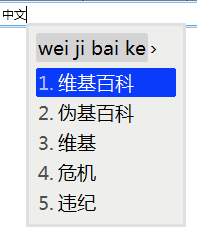Input method


An input method (or input method editor, commonly abbreviated IME) is an operating system component or program that allows any data, such as keyboard strokes or mouse movements, to be received as input. In this way users can enter characters and symbols not found on their input devices. Using an input method is obligatory for any language that has more graphemes than there are keys on the keyboard.
For instance, on the computer, this allows the user of Latin keyboards to input Chinese, Japanese, Korean and Indic characters; on many hand-held devices, such as mobile phones, it enables using the numeric keypad to enter Latin alphabet characters (or any other alphabet characters) or a screen display to be touched to do so. On some operating systems, an input method is also used to define the behaviour of the dead keys.
Implementations
Although originally coined for CJK (Chinese, Japanese and Korean) computing, the term is now sometimes used generically to refer to a program to support the input of any language. To illustrate, in the X Window System, the facility to allow the input of Latin characters with diacritics is also called an input method.
On Windows XP or later Windows, Input method, or IME, are also called Text Input Processor, which are implemented by the Text Services Framework API.
Relationship between the methodology and implementation
While the term input method editor was originally used for Microsoft Windows, its use has now gained acceptance in other operating systems, especially when it is important to distinguish between the computer interface and implementation of input methods, or among the input methods themselves, the editing functionality of the program or operating system component providing the input method, and the general support of input methods in an operating system. This term has, for example, gained general acceptance on the GNU/Linux operating system; it is also used on the Mac OS.
- The term input method generally refers to a particular way to use the keyboard to input a particular language, for example the Cangjie method, the pinyin method, or the use of dead keys.
- On the other hand, the term input method editor on Microsoft products refers to the actual program that allows an input method to be used (for example MS New Pinyin). PRIME, or SCIM prefer the term of Input Method Engine, Input Method platform or Input Method environment, or the actual editing area that allows the user to do the input. It can also refer to a character palette, which allows any Unicode character to be input individually. One might also interpret IME to refer to the editor used for creating or modifying the data files upon which an input method relies.
See also
Related techniques
- Alt codes
- Keyboard layout, in particular dead keys
Input methods versus language
- Chinese input methods for computers
- Japanese language and computers and Japanese input methods
- Korean language and computers
- Vietnamese language and computers
- Indic scripts input methods for languages used in South Asia, Southeast Asia, and parts of Central Asia and East Asia.
Specific input methods
- List of input methods for UNIX platforms
- ATOK, and MS IME for Windows
- Tise—Tibetan IM for Windows
- Singlish Typewriter—Sinhala IM
- Wnn
Input methods for handheld devices
- Multi-tap—Used on many mobile telephones—hit the (combined alphanumeric) key for the letter you want until it comes up, then wait or proceed with a different key.
- T9/XT9—Type the key for every letter once, then, if needed, type Next until the right word comes up. May also correct misspellings and regional typos (if an adjacent key is pressed incorrectly).
- iTap—Similar to first-generation T9, with word autocomplete.
- LetterWise—"Hit the key with the letter you want, if it doesn't come up, hit Next until it does."
- Fleksy—Eyes-free touch typing for touchscreen devices, also used by blind / visually impaired people.[1]
- SwiftKey - context-sensitive word-prediction[2][3]
- FITALY An array, almost square, which minimizes distance traveled from one letter to another.
- MessagEase, an input method optimized for the most common letters, that can enter hundreds of characters with single hand motions
- Swype, an input method that uses swiping gestures instead of tapping to quickly enter text
- 8pen, an input method using circular swipes in an attempt to mimic hand movements
- Google Keyboard, the keyboard that comes bundled with the Android operating system
- Graffiti, the Palm OS input method, entered using a stylus
- Pouces, an input method using touches and swipes
References
- ↑ Meddaugh, Jason (2013-02-01), 2012: A Technology Year in Review, USA: American Foundation for the Blind, retrieved 2013-02-25,
Our top story of 2012 involves a formerly little-known app called Fleksy and its rise toward prominence and mainstream acceptance.
- ↑ Fiedlerová, Klára (2012-05-10), Possibilities of Text Input for Handicapped People (PDF), Prague: Czech Technical University in Prague, p. 15, retrieved 2012-08-01,
Word prediction is used to speed up the text entry. The prediction system uses the context of the sentence to predict three words that could be used next.
- ↑ "For phones - SwiftKey". SwiftKey. TouchType. Retrieved 2016-10-21.
External links
- Microsoft Input Method Editors (IMEs) for Chinese, Japanese and Korean
- BhashaIndia, the Microsoft portal for Indic languages, which has Indic IME for download.
- Google Transliteration IMEs
- UrduIME An IME for Urdu Language
- InputKing Online Input System, with this online IME, you can type your language anywhere.
- CJKV Input Method Editors for MS Word VBA macros for input Asian characters and for text conversion.
